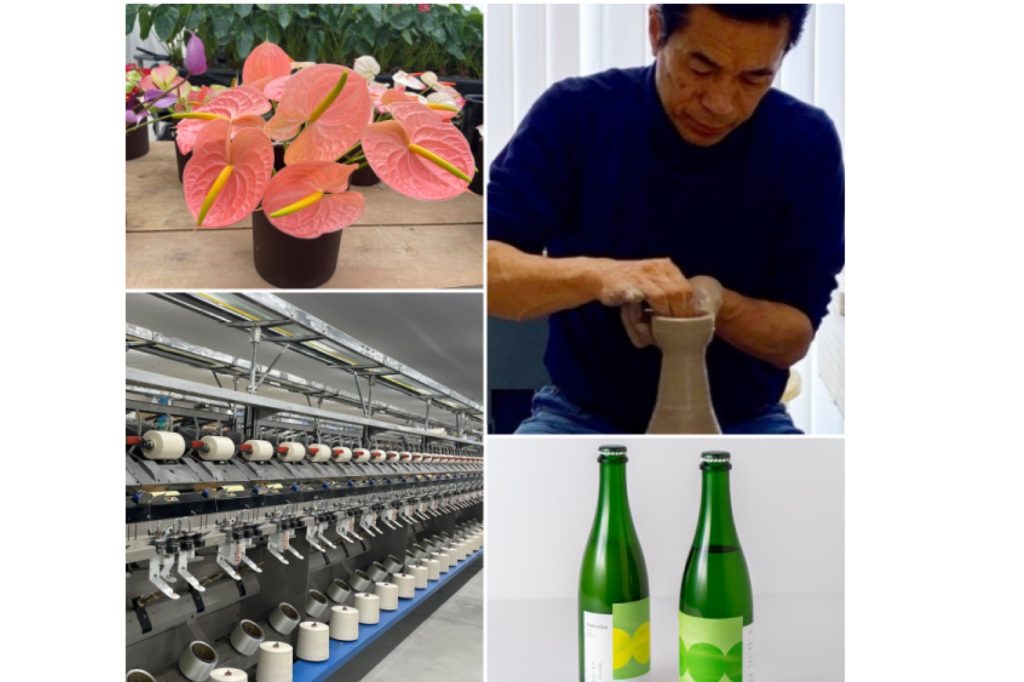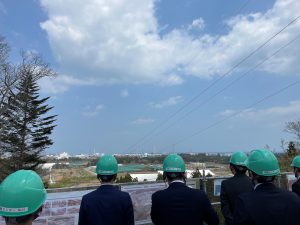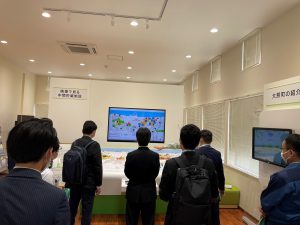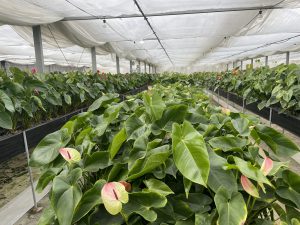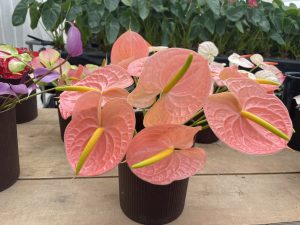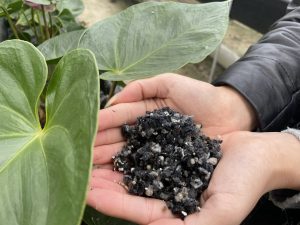実施日 : 2024年02月27日(火) - 28日(水)
Fukushima Press Tour
投稿日 : 2024年02月01日
Fukushima Press Tour
The Frontline of Efforts to Rebuild the Local Economy
Tour Dates: Tuesday, February 27 - Wednesday, February 28, 2024
Sponsor: Ministry of the Environment, Japan (MOEJ)
APPLICATIONS ARE CLOSED, THANK YOU!
【Tour Topics】
① Initiatives to Create Jobs and Revive Traditional Industries in Areas Where Evacuation Orders Were Lifted
② New Industries Created by Entrepreneurs Relocating to Fukushima
Nearly 13 years have passed since the Great East Japan Earthquake and the accident at the TEPCO’s Fukushima Daiichi Nuclear Power Station. For Fukushima Prefecture, where up to 164,000 people were forced to evacuate due to the earthquake and nuclear accident, 2024 also marks ten years since the evacuation order was lifted for the Miyakoji District in Tamura City, the first evacuation orders to be lifted for an area within a 20-kilometer radius of TEPCO's Fukushima Daiichi Nuclear Power Station.
By March 2020, evacuation orders had been lifted for all areas except for the Restricted area. In the Restricted area, decontamination and infrastructure development were carried out in six municipalities designated as Specified Reconstruction and Revitalization Base Areas, to be used as bases for economic activities and daily living, and the evacuation orders for them were all lifted by November 2023. Total area of Fukushima Prefecture covered by evacuation orders have decreased from around 12% to around 2.2%, and in FY2024 further decontamination efforts to prepare for the return of residents will take place in Specific Revitalized Residential Area, which are zones in Restricted area which are designated separately from the Specified Reconstruction and Revitalization Base Areas, with the aim of allowing residents to return and rebuild their lives after the evacuation orders have been lifted.
This tour will visit areas that have made a new start with the lifting of evacuation orders, covering efforts by companies to create jobs and residents doing their best to protect local traditional industries that were at risk of dying out. The tour will also visit two entrepreneurs who moved to Fukushima from outside the prefecture to learn about their efforts towards community building and stimulating local industries.
【Tour Details】
Topic① Initiatives to Create Jobs and Revive Traditional Industries in Areas Where Evacuation Orders Were Lifted
-The current status and future of Fukushima’s decontamination
- Photos courtesy of MOEJ
According to the Ministry of the Environment, Japan, "the Interim Storage Facility straddles Okuma and Futaba, and was built around the TEPCO’s Fukushima Daiichi Nuclear Power Station to safely manage and store soil and radioactive waste removed as part of the decontamination process until it will be finally disposed of. It was a major decision for the towns of Okuma and Futaba to accept its construction".
Transportation of soil and waste to the 16-square kilometer facility began in 2015, and by the end of December 2023, the total amount of soil and waste reached approximately 13.75 million cubic meters (including from the Restricted area). From 2024 onward, it is expected that more removed soil and waste are transported from the Specific Revitalized Residential Area in the Restricted area, which will be constructed outside the Specified Reconstruction and Revitalization Base Areas.
It is clearly stipulated in the law, that after being temporarily stored in the Interim Storage Facility, the removed soil and waste are supposed to be finally disposed of outside of Fukushima Prefecture within 30 years after the start of transportation to the Interim Storage Facility (by March 2045).
◆During the tour, Soil Storage Facilities, etc. will be shown with an explanation from MOEJ staff.
2.Asanonenshi Co., Ltd.: Futaba Super Zero Mill (Futaba Town)
- A gigantic twisted yarn factory creating jobs and interaction in Futaba Town, where residents have returned for the first time in eleven and a half years

Photo (left) courtesy of Asanonenshi
In Futaba Town, all of its approximately 7,000 residents had to leave the town due to evacuation orders after the nuclear accident. In August 2022, the evacuation orders were partially lifted, with people once again permitted to reside there after eleven and a half years.
The town’s new start is being supported by the Futaba Super Zero Mill, which opened in April 2023. Asanonenshi Co., Ltd., a twisted yarn manufacturer which has its head office in Gifu Prefecture, operates the facility, and in addition to a twisted yarn factory it includes event spaces, stores selling towels, and a café. It is not only creating jobs in this area affected by the disaster, but also providing residents with a space where they can interact with each other and helping stimulate the local economy as a center for tourism.

Photo (left) courtesy of Asanonenshi
The Futaba Super Zero Mill makes Super Zero twisted yarn, made with a unique and world's first method using water-soluble threads. The Super Zero which is characterized by not only its lightness and soft texture, but also has an excellent water absorption and quick drying properties, and it has been delivered to a towel company and other major manufacturers in Japan. In addition, Asanonenshi established its own towel brand, "Air Kaol", in 2007. Air Kaol towels became a hit product, with over 15 million cumulative sales.
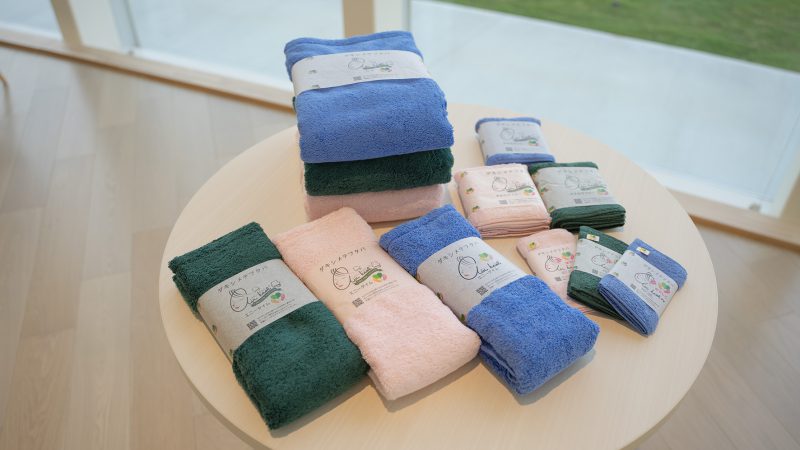
Photo courtesy of Asanonenshi
In spring 2024, when the 20 yarn twisting machines begin their full operation, the Futaba Super Zero Mill will produce 500 tons of Super Zero annually, Asanonenshi plans to export the yarn overseas in earnest. A deal has already been made to provide a major Chinese towel manufacturer with the yarn, and negotiations are underway with a famous European brand, with hopes to expanded exports that will make Futaba becoming well-known overseas.
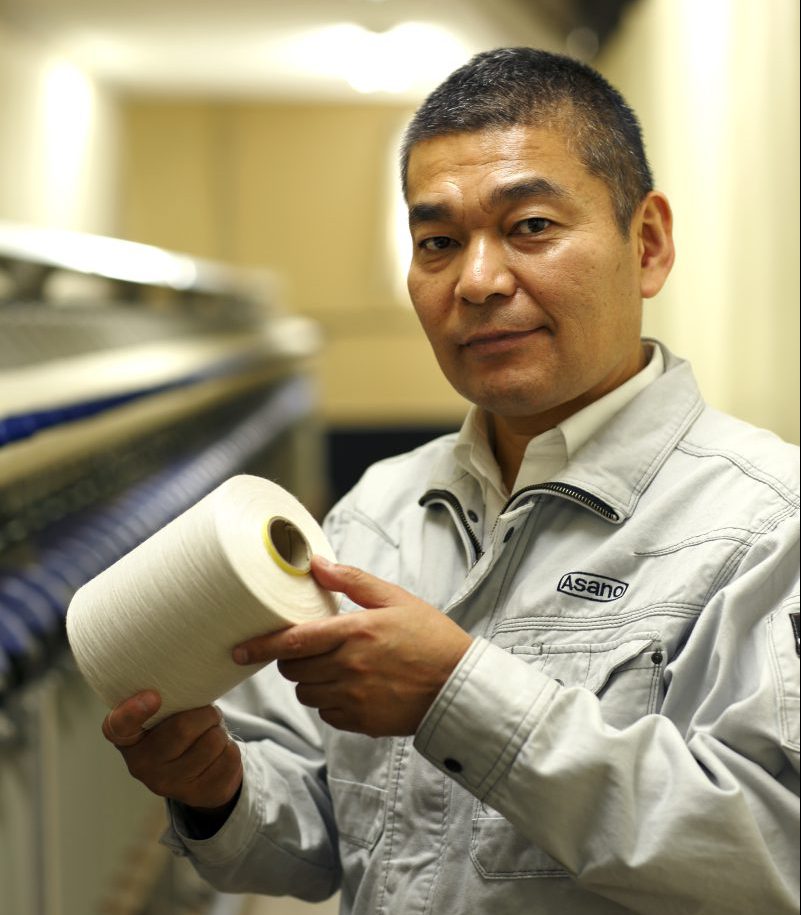
Photo courtesy of Asanonenshi
When being asked the reason why Asanonenshi, with its head office located in Gifu Prefecture, invested three billion yen for establishment of the facility in Futaba Town, company president Mr. ASANO Masami responded that when he saw the people of Futaba Town working on reconstruction for the future despite their difficult situation, he decided, “I want to learn from these people. I want to work together with them.” He also went to university in Fukushima Prefecture. In order to help revitalize the local economy, Asanonenshi is aiming to draw in domestic and overseas tourists with the Futaba Super Zero Mill, hoping to create nonresident population of three million per year.
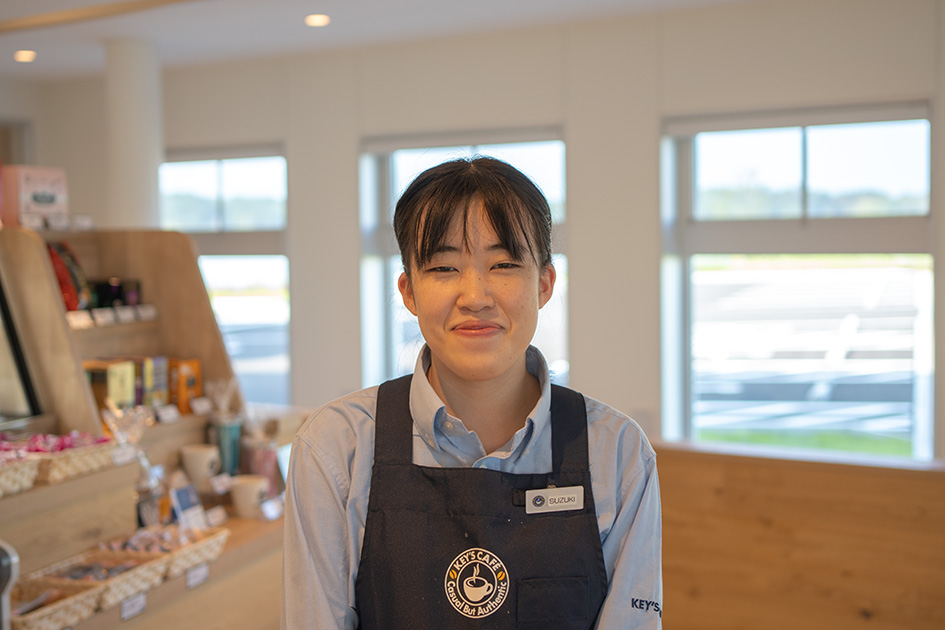
Photo courtesy of Asanonenshi
Of the 20 Asanonenshi employees at the Futaba Super Zero Mill, nine transferred from the head office in Gifu Prefecture, and the other eleven were hired in Fukushima Prefecture, from places such as Iwaki City and Minamisoma City. Ms. SUZUKI Shiho, who graduated from a high school in Fukushima Prefecture in 2023, decided to join Asanonenshi after she was inspired by Mr. ASANO’s passion towards reconstruction, and having decided she wanted to help Futaba Town after seeing the situation of the town with her eyes. Having left her hometown of Iwaki City, she now lives by herself in Futaba Town while working at the Futaba Super Zero Mill café.
◆The tour will visit the Futaba Super Zero Mill and see the twisted yarn factory while hearing from Mr. Asano about the company and his thoughts on Futaba’s reconstruction. There will also be an opportunity for interviews with two employees from Fukushima Prefecture, including Ms. SUZUKI Shiho.
3.Obori Soma Ware Kiln: Toukichirougama (Namie Town)
- One year after the lifting of the evacuation order. A potter who rebuilt a workshop in the place where a local industry began, to protect 300 years of tradition
In areas where the local community has fallen apart due to the long-term evacuation orders, approaches to protect and pass on local traditions and culture has become an issue to be addressed. In the Obori District of Namie Town, the Obori Soma ware, a type of ceramic with over 300 years of history, is one of those traditions facing an existential crises.
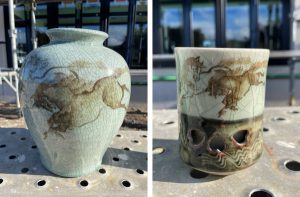
Obori Soma ware began to be produced in the Obori District of Namie Town during the Edo period, around 1690. Its characteristics include blue cracks throughout the dishes, masterfully drawn pictures of horses, and a double-layered structure. There were over one hundred Obori Soma potteries active at the end of the Edo period, and Obori is said to have prospered as the top ceramics producer in the Tohoku region. It was exported overseas in the 1950s, and the double-layered cups became popular in the US, where they were called “idea cups” or “double cups.”
In 1978, Obori Soma ware was designated by the national government as a Traditional Craft Product. Despite being beloved by many people as a local specialty of Namie, after the nuclear disaster the Obori District was designated as Restricted area, and the over 20 potteries located there had to evacuate. Several decided to close their business, and there are currently 14 potteries continuing their work outside of the town.

In March 2023, the evacuation order for the Obori District was lifted, and there is one pottery which has decided to return to the birthplace of Obori Soma ware in order to start making it there again: Toukichirougama, which has continued since the Edo period. After the nuclear accident, the pottery continued its production in Iwaki City, but having rebuilt a workshop and storefront in Obori, they plan to restart business there for the first time in 13 years, in spring 2024.
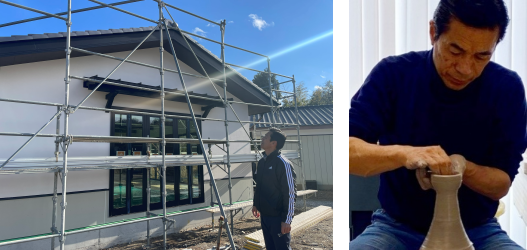
Photo (right) courtesy of Toukichirougama
When being asked the reason why he decided to operate in Obori, Mr. KONDO Manabu of Toukichirougama responded, “True tradition means making it where it originated.” In order to revive this tradition in Namie, where it has nearly disappeared, and pass it on to the next generation, Mr. KONDO also puts his effort into training potters.
◆The tour will visit the rebuilt Toukichirougama workshop in Obori, to hear from Mr. KONDO about his thoughts on passing on tradition, and provide an opportunity to see procedures using a potter’s wheel.
Topic② New Industries Created by Entrepreneurs Relocating to Fukushima
In order to accelerate the reconstruction and revitalization of 12 municipalities which were put under evacuation orders due to the nuclear accident, Fukushima Prefecture is encouraging people to relocate from outside the prefecture. Providing support including up to two million yen in relocation subsidies to people who relocate to these 12 municipalities (more generous support than other regions), in FY2022 603 people moved to those municipalities, nearly 40% more than in the previous fiscal year. For entrepreneurs relocating from outside of the prefecture starting businesses in these 12 municipalities, there is also a subsidy for up to 4 million yen of the startup costs, and the number of people seeking to solve the issues of the disaster-effected areas through entrepreneurship is growing.
4.haccoba(Minamisoma City / Namie Town)
- Starting a business in Fukushima after moving from Tokyo. Supporting community building in disaster-affected areas through a craft sake brewery
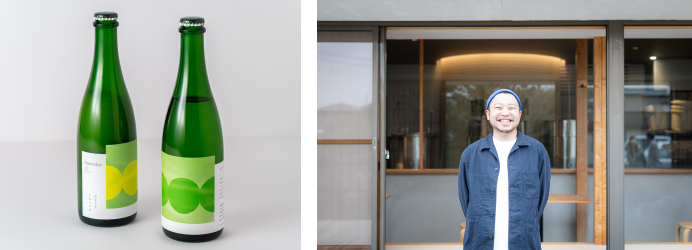
Photos courtesy of haccoba
Mr. SATO Taisuke, originally from Saitama Prefecture, worked in Tokyo at a major IT company and other jobs before moving to Minamisoma City in 2020 and establishing haccoba, a sake company. In addition to having an interest in sake production for a long time, he wanted to contribute to community building in the disaster-affected areas by making the sake brewery a place where local residents could gather, and this is why he decided to start his business in Minamisoma City.

Photos courtesy of haccoba
"haccoba" makes craft sake, adding extra ingredients such as hops, spices, and raspberries to the traditional ingredients of sake (rice and koji) and it is classified as “other brewed alcoholic beverages” according to the Japanese liquor tax law. In addition to the rice and koji, some of the secondary ingredients made in Fukushima Prefecture are also used, and the company is working together with local farmers to make sake without boundaries.
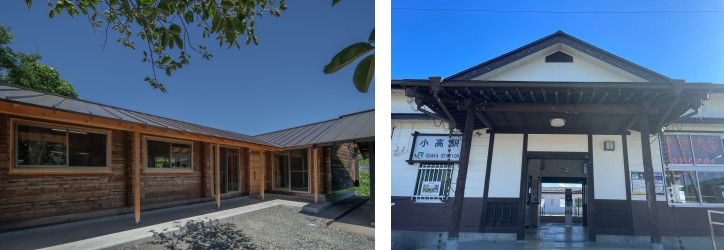
Photo (left) courtesy of haccoba
With the goal of community building based around sake breweries, haccoba is also intent on increasing the number of breweries they have. In addition to the brewery in Minamisoma City, in July 2023 they built a new brewery in Namie Town, reusing logs which had been used for temporary housing. A brewery and store using the JR Odaka Station building in Minamisoma City is planned to be completed in February 2024. A train station with a brewery attached is a rarity even in the rest of Japan, and Mr. SATO explained, “By locating it at the train station, a place symbolic as the entrance to the town, and by building a shop with local specialties alongside it, I want it to fulfill a role as a headquarters for disseminating local information.”
◆The tour will visit the brewery in Namie Town to interview Mr. SATO and see the sake production. Afterwards, the tour will go to the JR Odaka Station, and see the recently complete brewery and store, and have a craft sake tasting for those journalists who are interested.
5.smile farm Co., Ltd. (Kawamata Town)
- After the nuclear disaster, anthuriums became a new local specialty of Kawamata Town. A new farmer who relocated from outside the prefecture is using a unique growing method with polyester instead of soil
In Kawamata Town, where evacuation orders were lifted for the entire town by March 2017, efforts are being made to stimulate the town by making anthurium cultivation into a new local industry.
Anthuriums are decorative plants native to the tropics of the Americas, with heart-shaped leaves which have a smooth, enamel-like texture. In Kawamata Town, anthuriums are being grown using polyester from recycled clothes as a culture medium instead of soil. By not using soil, the risk of continuous crop failure is reduced, and it also helps to counter soil contamination from the nuclear accident and dispel harmful rumors.
With support from Kindai University, experimental cultivation began in 2015, and in 2018 cultivation began in earnest with eleven farmers involved. In 2022, over 300,000 anthuriums were grown in one year, and with a national market share of around 40%, Kawamata Town is now the largest producer of anthuriums in Japan.
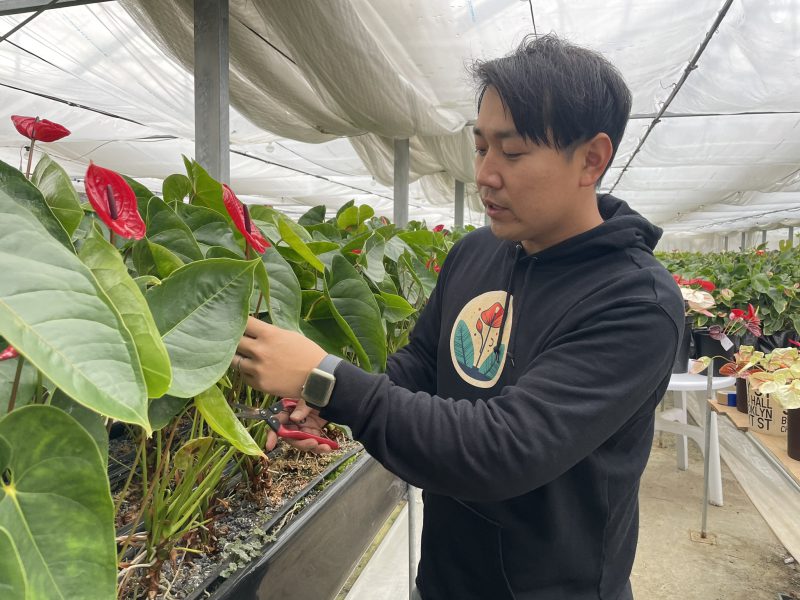
Some of the farmers who grow anthuriums in Kawamata Town have relocated from outside the prefecture. Mr. TANIGUCHI Goki, from Saitama Prefecture, is one of them. When working as staff at a golfing goods sales company, he was transferred to Fukushima City in 2013. When he was ordered to transfer to another prefecture a few years later, he made a decision to quit his job and stay in Fukushima together with his wife who is from Kawamata Town. In 2018, they moved to the Yamakiya District in Kawamata Town and began growing anthuriums.
The temperature in Yamakiya District could drop to as low as minus 10°C in the winter, and the fuel to heat an agricultural greenhouse costs around 1.5 million yen per year. By implementing smart agriculture that automatically controls the temperature in the greenhouse and watering the plants, Mr. TANIGUCHI has succeeded in lowering the cost and increasing efficiency.
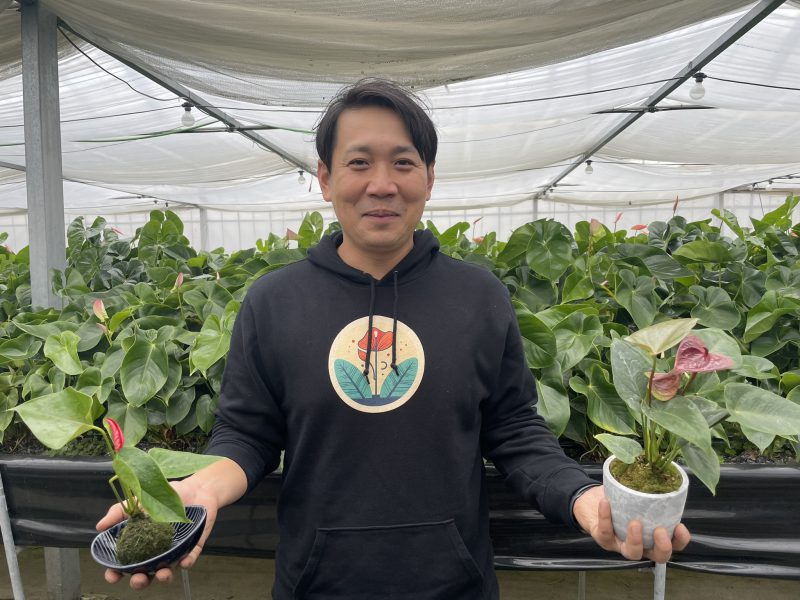
In addition to growing around 50,000 anthuriums per year, in 2021 Mr. TANIGUCHI established Smile Farm, a tourist farm where visitors can enjoy flower arranging and picking strawberries. He commented, “I want to bring in 10,000 people in 2024, and have more people who learn about Kawamata Town’s anthuriums.”
◆The tour will visit Smile Farm, and after hearing from Mr. TANIGUCHI about the business of growing anthuriums, will also visit where the anthuriums are grown.
【Tour Itinerary】
1.Dates
Tuesday, February 27 to Wednesday, February 28, 2024
2.Schedule
【Tuesday, February 27】
07:40-08:56 Tokyo Station–Koriyama Station (Shinkansen Yamabiko 125)
11:00-12:30 Toukichirougama (Namie Town)
13:00-13:40 Lunch at Michinoeki Namie (Namie Town)
14:00-15:45 Interim Storage Facility
16:15-17:25 haccoba Namie brewery (Namie Town)
17:50-18:30 haccoba JR Odaka Station brewery and store (Minamisoma City)
19:00 Arrive at hotel (Namie)
【Wednesday, February 28】
09:30-10:30 Ministry of the Environment, Japan's briefing (Hotel conference room)
10:45 Leave hotel
11:00-13:00 Asanonenshi Futaba Super Zero Mill (Futaba Town)
13:10-13:50 Lunch at Restaurant F (Futaba Town)
15:00-16:30 smile farm (Kawamata Town)
18:16-19:48 Fukushima Station–Tokyo Station (Shinkansen Yamabiko 154)
3.Qualification
Bearer of the Ministry of Foreign Affairs of Japan Press Registration Card (in principle)
4.Cost
13,000 yen per person, including transportation, accommodation (dinner and breakfast included).
*Information on payment and cancellation fees will be provided to participants.
*Participants will be required to pay their own transportation costs to the meeting place before the tour, and after the tour ends.
5.Participants
Limited to 10 participants. (Only one reporter or one photographer from each company, but two participants from each TV team will be acceptable.)
*If the number of participants exceeds the capacity, the organizer may make adjustments.
6.FPCJ Contacts
SHIMIZU (Ms.), YOSHIDA (Ms.), Media Relations Division
(Tel: 03-3501-3405, E-mail: ma@fpcjpn.or.jp)
7.Please be sure to confirm and agree to the following before applying:
7-1.Basic Information
(1) This tour is organized by MOEJ and run by the FPCJ.
(2) The schedule is subject to change without notice.
(3) This tour will require participants to bear a part of the cost but is not a profit-making venture.
(4) MOEJ and the FPCJ take no responsibility for any accidents, injuries, illness, or other problems which occur during the tour.
(5) There may be some restrictions on photographing and filming at the tour sites. Please follow the instructions of the staff in charge.
(6) This press tour is intended to provide opportunities for news coverage. We request that all participants send a copy of the content of their coverage (article, video, or audio in the case of radio) to the FPCJ after their reports are published or aired. When your report is in a language other than English or Japanese, we also ask you to provide a summary in English or Japanese. By submitting your application, we assume that you have agreed to these conditions.
7-2.Handling of Personal Information
When applying for the tour, you agree to the below.
*Regarding the handling of personal information, the press tour sponsors and operators will respect Japan’s Act on the Protection of Personal Information and all other laws and guidelines on the protection of personal information and handle personal information appropriately.
(1) The tour operators will, when there is a need to do so for the press tour, provide the personal information provided when applying (organization name, personal name, etc.) to other parties in the following cases: -To arrange travel or insurance through travel agencies (Information provided to: Travel agencies, accommodation operators, transportation operators, insurance companies) -To ensure smooth operations during the tour (Information provided to: Interpreters, stops on the tour, interviewees)
(2) The tour operators, to ensure smooth operation of the tour, will share the personal names and organization names of applicants with the tour sponsors.
7-3.Recordings by Press Tour Sponsors or Operators During the Tour
When applying for the tour, you agree to the below.
(1) For the record-keeping purposes, the tour operators may film or photograph the tour while it is happening. The copyright holders for these photos or videos will be the tour sponsors.
(2) Photos, videos, or articles of the press tour may be uploaded to websites or social media accounts operated by the sponsors or operators.
(3) The likeness or voice of participants may appear in the abovementioned photos or videos, but you agree to their use by the sponsors or operators.
7-4. As COVID-19 has been reclassified as a Class 5 infectious disease, we request you to take the following measures when participating in the tour.
- Ensure you are healthy before joining the tour.
- The decision to wear masks is up to individual choice, and this decision will be respected.
- Please follow measures to prevent the spread of infection, such as cough etiquette to prevent airborne droplets when coughing or sneezing in the bus.
- Please wash your hands and gargle before the tour and before getting on the bus.
- Use your assigned seat on the bus, and refrain from switching seats.
**************************
◆When applying for the tour, you agree to the following conditions◆
- Press tours have participants from multiple media organizations, and interviews, filming, and photographing are generally carried out jointly. There is no guarantee that you will be able to perform individual interviews or take individual videos at any of the stops on the tour.
- You must follow the instructions of the tour sponsor and operators regarding the tour schedule, timing, and restrictions on taking videos or photos. If you refuse to follow instructions, you will no longer be allowed to participate in the press tour from that point on.

